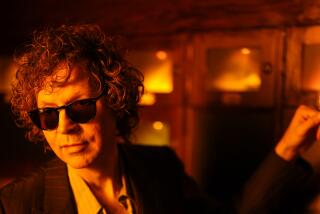Braxton’s Quest Leads Him Beyond Jazz
- Share via
“I have been viewed as a guy who’s pretty far out, severed from the public, but I see myself as very traditional,” said composer-musician Anthony Braxton. “I’ve wanted to maintain a relationship with my work based on my belief about music--I’ve tried to follow my heart and my natural attractions.
“I see my life’s work as part of a spiritual need for myself. I’m just a guy who discovered sound and music, who discovered hundreds and thousands of men and women who have put their lives on the line for the discipline of music because it was that important to them. I was fortunate to be motivated and inspired by their efforts and I seek to be a part of that fraternity.”
Braxton, whose main instrument is alto saxophone but who plays virtually every reed instrument, makes his first Los Angeles appearance since 1982 tonight in a duo concert with bassist Buell Neidlinger at McCabe’s in Santa Monica. The two musicians played together for the first time while recording Braxton’s “Six Monk’s Compositions” album in 1987.
“The duo context has always been one of the special contexts for me because it’s a one-on-one relationship,” said Braxton, 43, from his San Francisco-area home. “It gives a chance for a pure, total interaction from one person to the next. It’s a very good way to know a person.”
A Chicago native, Braxton came to prominence there when he became involved with the Assn. for the Advancement of Creative Musicians collective in 1966. He released three albums as a leader on the Delmark label before heading to Europe in the early ‘70s.
Braxton was recognized as one of the leading lights of jazz’s avant-garde wing during the ‘70s but resisted being categorized as a jazz artist. The 55 albums that he estimates have been released under his name range from solo saxophone performances to compositions for multiple orchestras.
“I feel fortunate that I separated myself from the word jazz and the jazz business complex,” Braxton said. “I have been free to pursue my work based on my own value systems.”
A central concept to Braxton’s value system is the idea of “restructuralism”--i.e, those musician-composers whose innovations changed the way music was structured. Braxton listed Arnold Schoenberg, John Cage, Charlie Parker, John Coltrane, Bob Marley and Steve Reich as prominent examples of musical “restructuralists.”
Braxton hasn’t ignored the jazz element in the multiple traditions he draws on; he released two albums of standards in 1985 and indicated that he may supplement his original compositions with one or two pieces from the jazz tradition at McCabe’s. But over the years he has designed a complex, erudite philosophical system--including the use of schematic designs rather than names to title his compositions--for developing his music.
Theoretical and educational facets of his work are becoming more important. Braxton is currently working on his third opera and has been teaching composition at Mills College in Oakland since 1985. He has also written a five-volume book, “Composition Notes,” analyzing the material and structure of 330 of his compositions, and a three-volume work “Tri-Axium Writings,” which delineates some of the philosophical underpinnings of his music.
“I wanted to understand what would constitute the science of my music, what it would be based upon.
“By documenting the process of the music, it is now possible to transfer that information. I think that’s part of the responsibility for those artists who feel inclined to move toward restructural activities. It’s not enough to just simply change the fundamentals--you must have some idea of what you’re doing and if it’s valuable. It should be possible to communicate about those changes.”
More to Read
The biggest entertainment stories
Get our big stories about Hollywood, film, television, music, arts, culture and more right in your inbox as soon as they publish.
You may occasionally receive promotional content from the Los Angeles Times.










